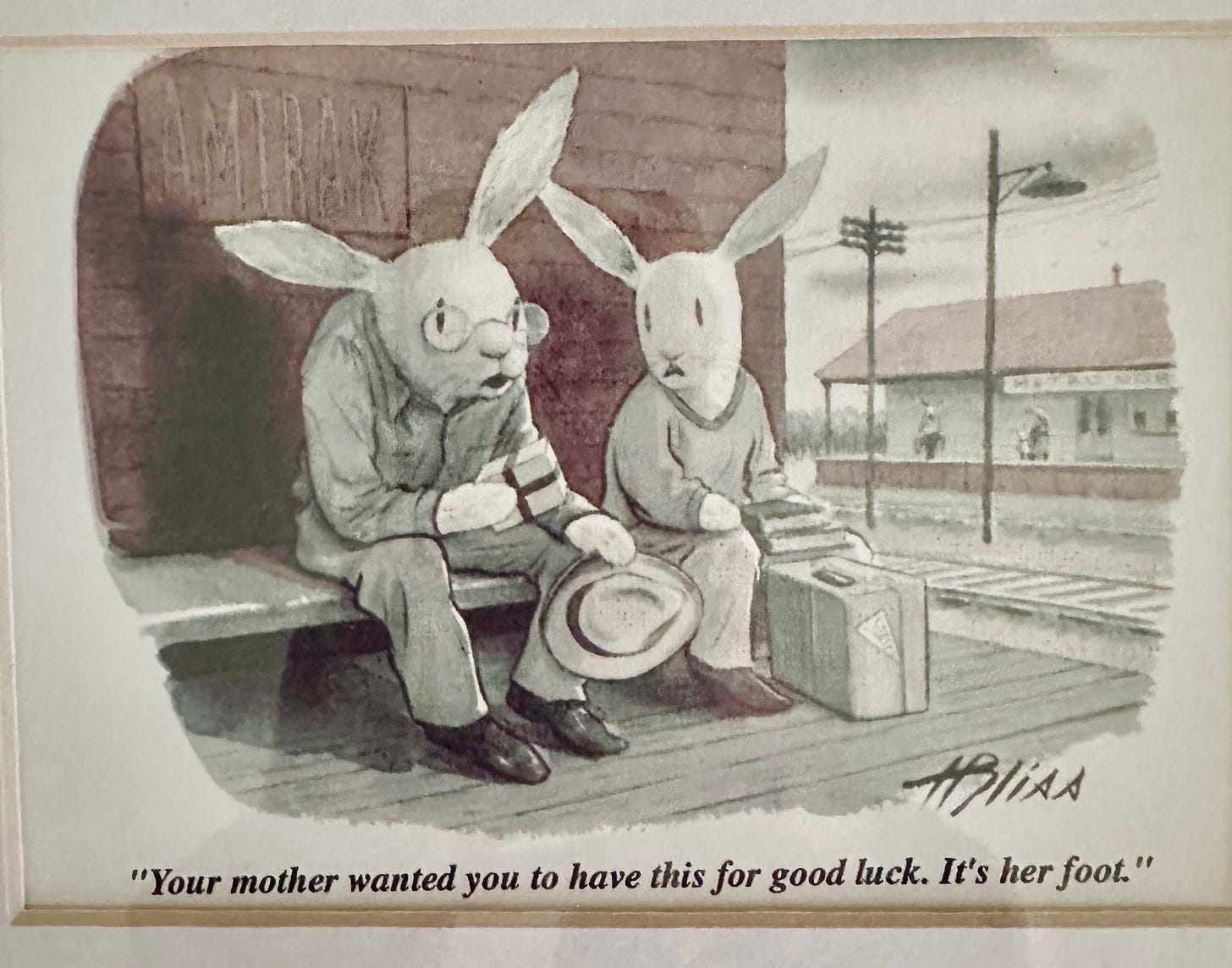The disappearance of this gas station trinket gives me hope
My child has no idea what a lucky rabbit's foot is, and I'm OK with that.
Every time I visit my in-laws in Minnesota, this framed cartoon hanging in their bathroom makes me chuckle:
This week, it dawned on me that my tween-aged daughter would have no idea what the joke is about. It might still be funny in an absurdist way, but not logical.
And that’s totally OK with me. Much like my post on the disappearance of sea turtle soup, the waning popularity of rabbit’s feet makes me feel a little bit better about humanity.
As a kid walking up to the counter at a South Texas gas station, I’d be confronted with dozens of them dangling at eye level in keychain form, all dyed hideously unnatural colors, yet still soft as, well, a bunny. (They were often found next to the Mexican jumping beans, which were actually trapped moth larvae. Fun!)
The feet weren’t fake. Beneath the fuzzy fur you could feel the bones and the claws tucked inside. It still makes me queasy all these years later. It also got me thinking: Why on earth did rabbit’s feet become such popular trinkets?
A messy history, of course
I’ve watched enough episodes of Alone to know when you’re starving and you catch (or snare) a rabbit, you indeed feel lucky. You can’t eat or wear the feet, so might as well imbue the leftovers with good luck. We certainly do weirder things (see: buccal fat removal). I assumed this was how the whole thing got started — as a hunting amulet?
But no. When I went down the internet rabbit hole1 (HA!), I discovered there is no simple origin. What first started out as folk medicine became superstition in many cultures. Romans, for example, thought carrying around a foot cut from a living rabbit could cure gout.
More recently, wearing a rabbit’s foot was thought to provide courage and strength, but only if the animal had been killed in a unique way, such as during the full moon on the grave of an enemy. (Something tells me you’re already brave if you’re hunting in a graveyard at night.)
At some point in the mid-20th century (for unclear reasons) this trend was popularized and rabbit’s feet basically became cheap trinkets:

While I don’t know if actual sales have declined since my youth (you can still order them on Amazon as both keychains or pet snacks—don’t let my cat know), their ubiquity has certainly faded. As these Reddit users remarked, neon-colored rabbit’s feet were once the main prize in the claw machines at skating rinks.
“I don’t know why it was so normal in 1992 to have a toy machine stuffed full of brightly colored dead animal bits,” one user remarked.
“Rabbits didn’t understand either,” someone quipped back.
Since I can’t remember the last time I saw any for sale, things seem to (slowly) be moving in the right direction? As someone who struggles with optimism about our wasteful relationship to the natural world, I’ll take what I can get.
https://blogs.scientificamerican.com/anthropology-in-practice/what-makes-a-rabbits-foot-lucky/ and https://centerforinquiry.org/blog/hares-to-you-rabbit-lore/





I'm pretty sure that the animal rights people put a stop to this being popular a long time ago. If they could stop rabbits from being the test subject for whether or not shampoo irritates eyes, they could stop their feet being chopped off for "good luck".
Besides, all the rabbits, bunnies and hares I know really need theirs....
So I googled if it's wrong to keep rabbit feet. I still have all my colorful ones from childhood. Fast forward and today i have raised and rescued many rabbits. But what about my childhood foot stash??? What should I do with them